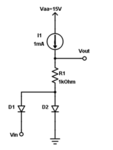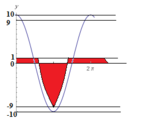userXY
Junior Member level 1
I need help with the following question:
For a given circuit

determine the waveform of voltage Vout, maximum values for positive and negative half-period segments, and the average value of voltage Vout. Assume that diodes are ideal.
Given data: Frequency of sine (or cosine) wave Vin is 1kHz with magnitude 10V.
Note: This is not homework. I am practicing for exam.
When Vin>0 diode D1 is OFF, and diode D2 is ON.
In this case we have Vout=I1*R1=1V.
When Vin<0 diode D1 is ON. and diode D2 is OFF.
In this case we have Vout=I1*R1+Vin=-9V.
Maximum values for positive and negative half-period segments are V1=1V,V2=-9V.
I am having a problem finding the average output voltage.
The graph is

The average output voltage is the area of a periodic function that is marked red.
Note that the first half-period segment is not a rectangle. The second part is a negative half-period segment of a cosine wave. We need to integrate that function which surface is marked red.
How to evaluate the average voltage of Vout?
For a given circuit

determine the waveform of voltage Vout, maximum values for positive and negative half-period segments, and the average value of voltage Vout. Assume that diodes are ideal.
Given data: Frequency of sine (or cosine) wave Vin is 1kHz with magnitude 10V.
Note: This is not homework. I am practicing for exam.
When Vin>0 diode D1 is OFF, and diode D2 is ON.
In this case we have Vout=I1*R1=1V.
When Vin<0 diode D1 is ON. and diode D2 is OFF.
In this case we have Vout=I1*R1+Vin=-9V.
Maximum values for positive and negative half-period segments are V1=1V,V2=-9V.
I am having a problem finding the average output voltage.
The graph is

The average output voltage is the area of a periodic function that is marked red.
Note that the first half-period segment is not a rectangle. The second part is a negative half-period segment of a cosine wave. We need to integrate that function which surface is marked red.
How to evaluate the average voltage of Vout?
Last edited: